NFC Card Technology: Past, Present and Future

In the ever-evolving landscape of modern technology, Near Field Communication (NFC) has emerged as a transformative force. NFC card technology, in particular, has played a pivotal role in reshaping the way we interact with our devices, conduct transactions, and share information. In this informative blog, we will delve into the history, current applications, and the promising future of NFC card technology.
The Past: The Birth of NFC
The roots of NFC technology can be traced back to the 1970s, when the concept of short-range wireless communication was first conceived. However, it took several decades for NFC to evolve into the robust system we know today. The NFC Forum, founded in 2002, brought together industry leaders to establish standards and drive the technology’s development.
The early applications of NFC cards primarily revolved around contactless payments, gradually replacing traditional magnetic stripe cards. However, these early NFC cards required physical contact with the reader, limiting their convenience. Data transfer was also relatively slow.
The Present: Ubiquity and Diverse Applications
Fast forward to the present, and NFC technology is an integral part of our daily lives. NFC cards have undergone significant improvements, becoming faster and more versatile. At its core, NFC enables two devices to communicate when in close proximity. It is based on a radio frequency identification (RFID) technology, which allows data to be exchanged between devices with a simple tap or wave.
Current Applications of NFC Card Technology
- Contactless Payments: NFC technology is now synonymous with contactless payments. By simply tapping or waving their NFC-enabled cards or smartphones near a payment terminal, users can swiftly and securely complete transactions.
- Access Control: NFC cards have found widespread use in access control systems. They are employed for secure entry to buildings, hotel rooms, and even public transportation.
- Smartphones and Wearables: NFC is integrated into a vast number of smartphones and wearables. This allows users to share files, pair devices, and make payments through their mobile devices.
- Transportation: Many public transportation systems have adopted NFC technology for fare collection. Commuters can tap their NFC cards or smartphones to access trains, buses, and subways, streamlining the travel experience.
- Healthcare: NFC cards play a crucial role in healthcare by ensuring secure access to patient records and medication information.
- Retail Loyalty Programs: NFC is instrumental in modern loyalty programs. Customers can tap their phones or cards to earn or redeem rewards.
- Information Sharing: NFC also facilitates easy information sharing. For example, at conferences or networking events, attendees can exchange contact details by tapping their NFC-enabled badges or smartphones.
The Future: Expanding Horizons
As we look to the future, NFC card technology is poised for further innovation and integration into various aspects of our lives.
Enhanced Security
NFC technology will likely see advancements in security. This may include the implementation of biometric authentication, making transactions even more secure.
IoT Integration
The Internet of Things (IoT) will benefit significantly from NFC. It can enable seamless communication between a multitude of devices, from smart home appliances to industrial sensors.
Healthcare Advancements
In healthcare, NFC technology can be expected to play an even more significant role. This includes improved patient tracking, access control, and secure sharing of medical data.
Retail Revolution
Retail experiences are likely to be transformed further by NFC technology. From cashier-less stores to enhanced product information, NFC will be at the forefront of this evolution.
Wider Adoption
The adoption of NFC technology will continue to grow, making it a standard feature in more devices and applications. This will further simplify our lives and make transactions even more convenient.
In conclusion, NFC card technology has come a long way since its inception, and its future looks promising. From its humble beginnings in contactless payments, NFC has expanded into numerous applications that enhance our daily lives. As technology continues to evolve, the role of NFC will become even more integral, providing us with convenience, security, and efficiency in our increasingly interconnected world. Stay tuned as NFC continues to shape the way we interact with the world around us.